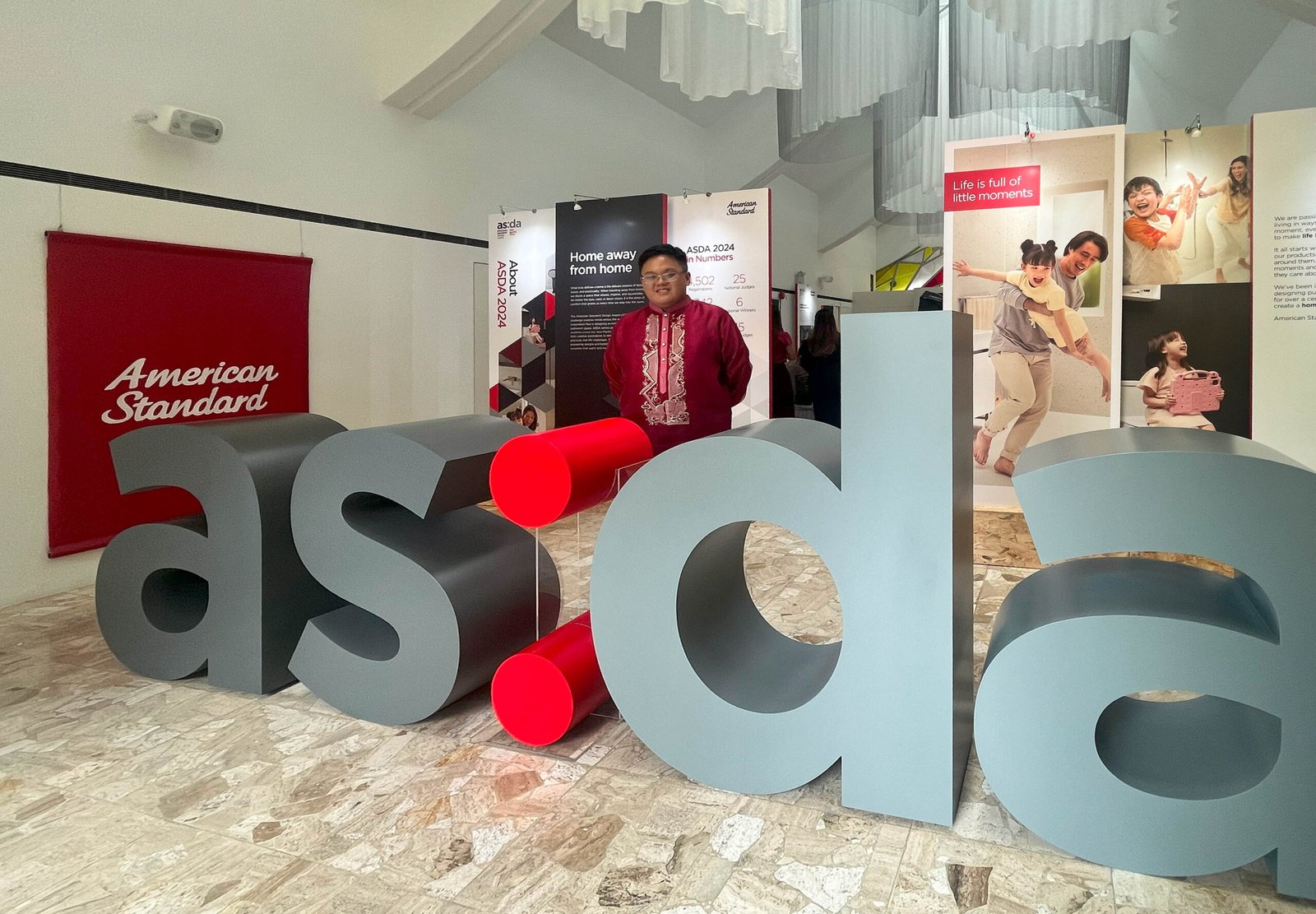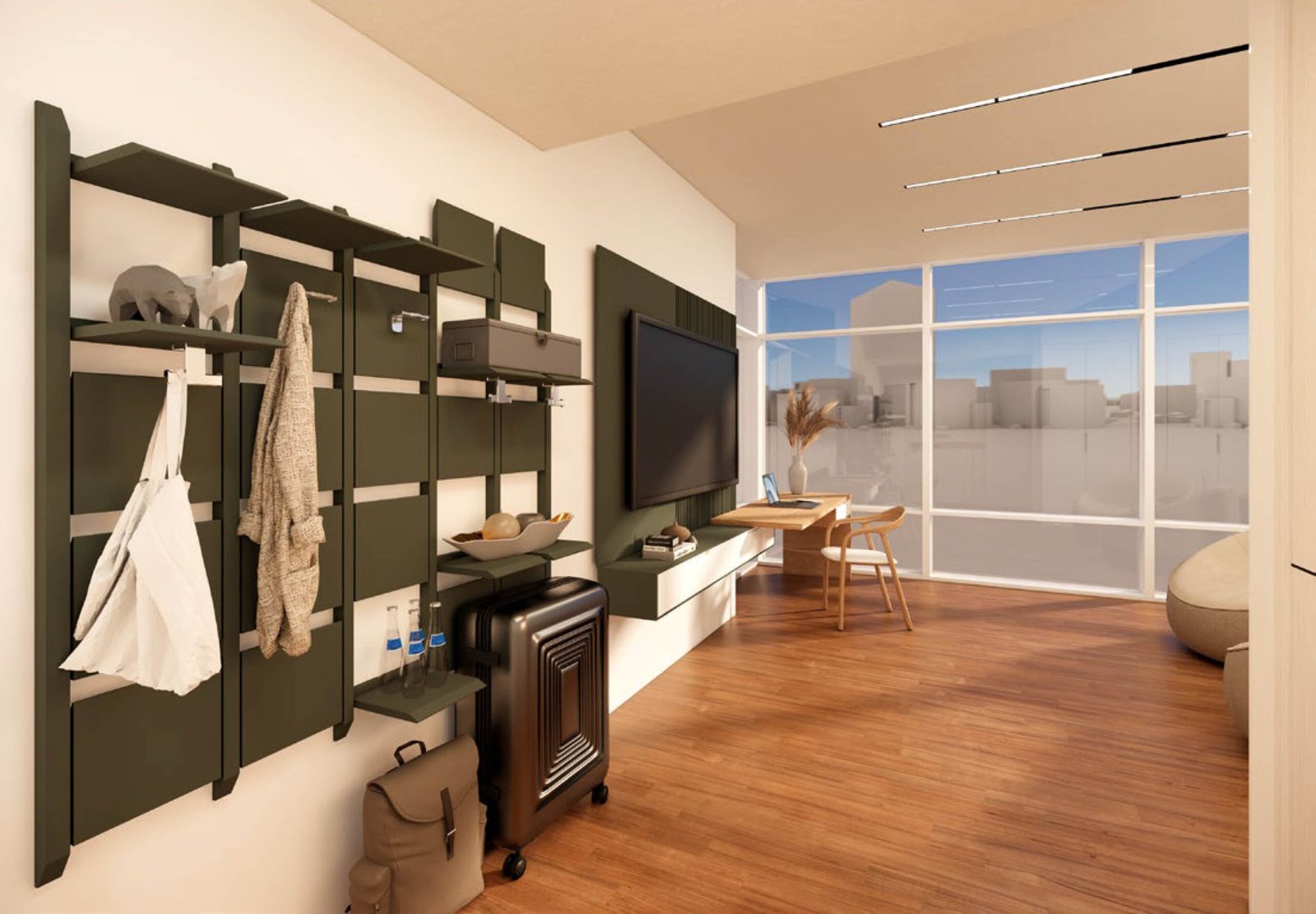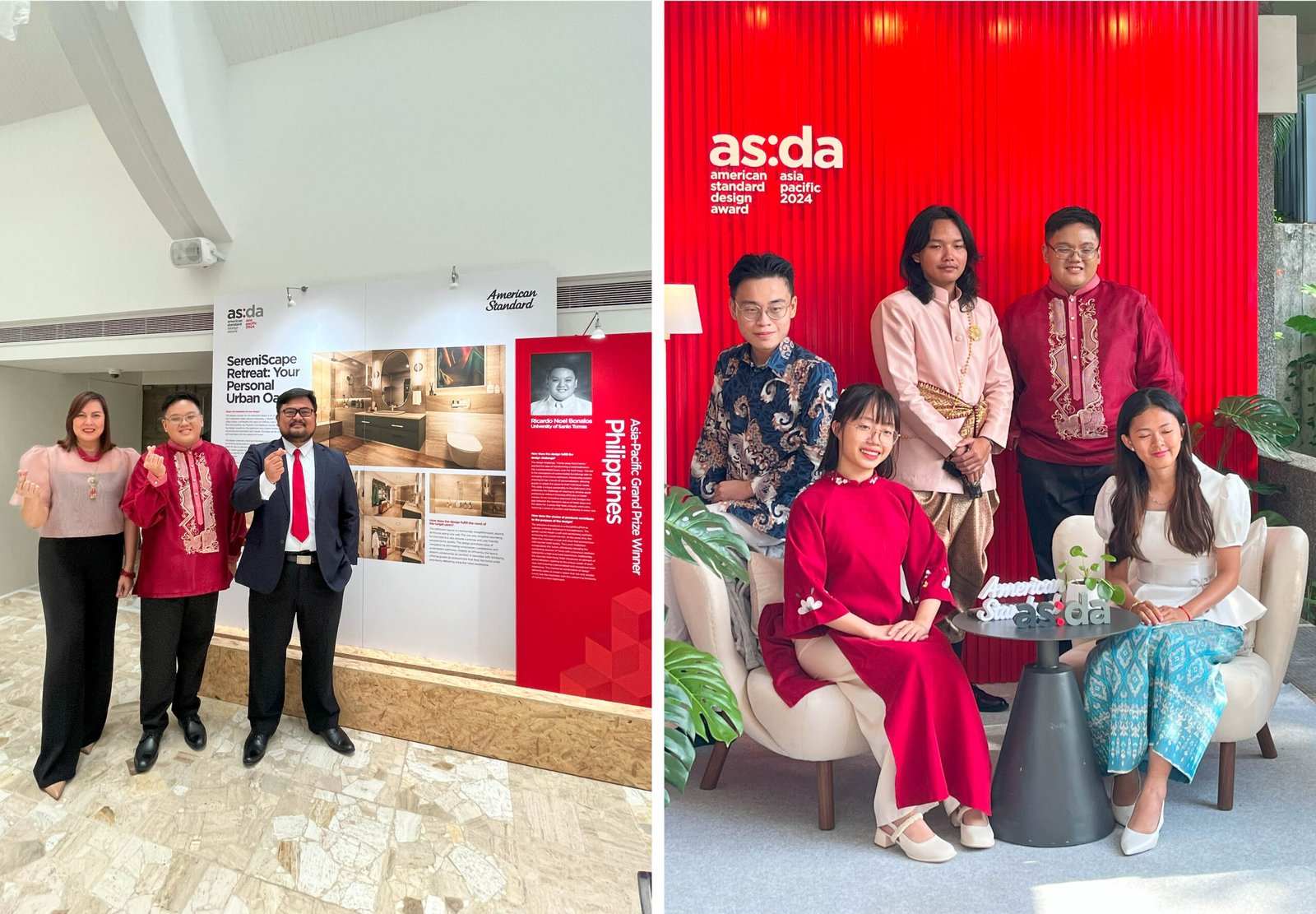Interview Patrick Kasingsing
Images LIXIL Philippines (ASDA 2024)


Congratulations, Rino, and welcome to Kanto! Before delving into your groundbreaking ASDA 2024 win, the first for the Philippines, let’s dive into the story behind your journey. Can you take us behind the scenes of your design process for SereniScape Retreat? How did you conceptualize the idea, and what were the essential steps to bring it to life?
Ricardo ‘Rino’ Bonalos, APAC grand winner of the American Standard Design Award (ASDA 2024): Hello, Kanto, and thanks for having me! I started by deciding on the ideal location for my design, ultimately choosing an urban high-rise hotel. The competition’s theme was “Home Away from Home,” and I envisioned creating a space that offers a breath of fresh air amidst the hustle and bustle of the city.
To ensure my design would meet the needs of both hotel owners and guests, I conducted thorough research, including watching trip vlogs and poring over hotel reviews and forums. This helped me identify common issues and bathroom preferences in this typology. A key challenge was creating a bathroom that feels familiar to frequently changing users while still offering personalization. The design elements needed to be both recognizable and customizable.
I developed four guiding principles for my design: Easy to Use, Easy to Clean, Easy to Maintain, and Easy to Understand. Easy to Use involved selecting user-friendly American Standard products and focusing on their featured offerings. Easy to Maintain and Easy to Clean emphasize high-quality materials and solutions facilitating swift housekeeping. Easy to Understand centered on creating a familiar and homey bathroom experience.
The SereniScape Retreat design creates a comforting and personalized atmosphere, blending functionality with tranquility. Natural elements are seamlessly integrated to offer guests a relaxing haven, fostering a home-like warmth in a serene oasis, wherever they may be.



Your design reimagines the typical hotel bathroom experience to incorporate more relaxation and personality, a balm for travelers far away from home. I’d love to hear about the creative design elements or features you used to bring this vision to life!
One of the key features of my design is customizable modular shelving, which allows guests to adjust the bathroom storage to suit their needs. This design element helps guests feel at home, as everything is where it should be, while still exuding the luxury of a high-end hotel bathroom. The bathroom’s straightforward layout ensures easy navigation, with all fixtures strategically placed on one side for maximum efficiency and comfort.
The shower area features a rain shower and a hand shower, controlled by the Acacia Evolution In-Wall Mixer. An adjacent shower bench adds a touch of comfort, providing a place to relax during the shower or to sit while drying off. The nearby towel shelf and bar ensure that towels are always accessible. I chose to use the Aero-lite Wall-Hung Toilet for the toilet area, which saves space and includes self-cleaning nozzles and hands-free operation with integrated UV technology for optimal hygiene.
High-quality materials, such as porcelain veneer slabs and rectified porcelain tiles, ensure the bathroom is stylish and easy to maintain. Marine plywood cabinetry guarantees longevity and moisture resistance. Additional personal touches, like the Acacia Evolution robe hooks and towel storage, maximize functionality and make guests feel genuinely at home. These elements create a functional, user-friendly space filled with relaxation and individuality, elevating the typical hotel bathroom experience.


You mentioned customization as intrinsic to your bathroom design vision. Can you explain how you made the space adaptable for different guests while keeping it cohesive and stylish?
Customization is indeed a cornerstone of my design for SereniScape Retreat. The standout feature is the modular shelving unit, designed to accommodate guests’ needs. The shelves can be easily raised or lowered to accommodate various storage requirements, making them versatile for different users. Additionally, the Acacia Evolution robe hook, positioned within the second row of shelves, maximizes storage options even when the shelves are adjusted, ensuring every inch of space is utilized effectively.
Carefully selected fixtures and materials maintain a cohesive and stylish aesthetic throughout the bathroom. The modular shelving allows the user to arrange their items in a way that adds color and character, seamlessly integrating with hotel-branded furnishings to create a unique yet cohesive look. This thoughtful design approach ensures that the bathroom remains consistent with the overall hotel design while allowing individual personalization.
Balancing functionality and aesthetics takes time and great effort, especially in a space with high utilization, such as a bathroom. Let’s discuss the decision-making process that has led to your product and design choices. How was American Standard’s collection of products a fit for your design vision?
Balancing function and form is a meticulous process that is also gratifying. One of the most exciting aspects of designing SereniScape Retreat was seamlessly incorporating American Standard’s versatile product range to achieve this balance.
The Acacia Evolution rain showerhead was a standout choice. Positioned at the ceiling, it creates an authentic rain shower experience that adds a touch of luxury. While the hand-held Rain Click shower, mounted on the Moonshadow shower rail, can be adjusted to the perfect height for each guest, making the shower experience highly customizable and satisfying. The Acacia Evolution Shower Mixer can control both shower options, which allows effortless control over the water temperature and flow.
In the toilet area, the Aero-lite wall-hung shower toilet was a game-changer. It’s designed with self-cleaning nozzles and hands-free operation, elevating the user experience with minimal effort. The integrated UV technology ensures optimal cleanliness, while the dual flush Concept flush plate above the toilet promotes water conservation without sacrificing performance. Another unique feature of the Aero-lite toilet is its LED night light, casting a gentle light inside the bowl and at the user’s feet, ensuring comfort and safety during nighttime use. Inspired by this, I incorporated similar night light technology into the vanity cabinet, providing soft, ambient lighting that helps guests navigate the bathroom at night without the harshness of full lights.
The Loven Collection from American Standard was crucial in achieving the perfect blend of style and functionality. The Loven Countertop Basin and Loven Basin Fixture brought elegance and practicality to the design.
American Standard’s product range was a perfect fit for my design vision. Their products met the high standards of quality and functionality I was aiming for and enhanced the bathroom’s overall aesthetic. This harmonious integration of thoughtful design and reliable products turned the SereniScape Retreat into a luxurious, user-friendly space embodying the “Home Away from Home” concept.


Let’s now talk about the competition proper. Any standout reactions or feedback you got about your design during or after the judging? How did these responses shape your view of your creation and your design process?
One of the standout feedbacks I received was from Antoine Besseyre des Horts (LIXIL Global Design Asia Leader), who appreciated how my design and modular furnishings enable user personalization. Jihae Kim (LIXIL APAC Category Management Leader) commended my thoughtful use of American Standard products and their strategic placement within the design. Additionally, all Philippine judges—IDr. Cynthia Almario, Ar. Cathy Saldaña and Ar. Richard Garcia—admired the simplicity and effectiveness of my design, even noting that they had learned something new to incorporate into their bathroom designs.
These responses deeply impacted my view of my design, providing validation and reinforcing my purpose as a designer. The positive feedback highlighted the importance of user customization and the necessity of careful planning and product selection. The judges’ admiration for my design’s simplicity and effectiveness emphasized the value of creating intuitive and user-friendly spaces. Their feedback has boosted my confidence and motivated me to pursue design excellence and innovation, knowing my work can inspire and educate others.


Winning the Asia Pacific title in the American Standard Design Award was an incredible feat! How do you believe entering competitions like this can empower young designers?
Winning the Asia Pacific title in ASDA 2024 was an incredible journey. It’s a huge honor to be the first in the Philippines to achieve this recognition. Competitions like this are invaluable for young designers as they provide a platform to showcase creativity, gain recognition, and connect with industry leaders. Participating pushes you to think innovatively, refine your skills, and apply theoretical knowledge to practical solutions. I advise aspiring designers to embrace challenges with passion and persistence, constantly pushing boundaries and exploring new ideas. Be open to feedback, learn from each experience, and never underestimate the power of networking. Competitions elevate your portfolio and foster personal growth, preparing you for future opportunities in the dynamic world of design. This experience has been a significant milestone in my career, and I look forward to the new opportunities and challenges it will bring.


Do you have any observations on how the national and regional legs of the competition differed for you? How did you adapt your approach based on the inclinations and priorities of the jurors?
Thinking ahead, I’ve always considered that my design needed not only to apply in the Philippine context but also to be adaptable internationally. I aimed to remove any sense of alienation based on theme, layout, or even my design title, ensuring it would apply to diverse cultures and preferences. This approach involved thorough consideration of universal design principles that could seamlessly integrate into various hotel and resort settings worldwide. Whether it’s adjusting the modular shelving to fit different bathroom layouts or ensuring the functionality of fixtures like the Aero-lite Wall-Hung Toilet, my goal was to create a design that is universally accessible and appreciated. By envisioning its application beyond local contexts, I aimed to contribute to a global conversation on hospitality design while promoting inclusivity and innovation in every aspect of my work.
Understanding the inclinations and priorities of the jurors was crucial throughout both stages. During the national competition, the top 10 finalists were also briefed on what each judge expected; it helped me focus on what I needed to show. I ensured my design narrative resonated with their innovation, sustainability, and guest-centric solutions and expectations. This approach helped me advance through the competition and highlighted the importance of adaptability and foresight in design thinking. Overall, the experience reinforced the significance of adaptability and innovation in design. It taught me invaluable lessons about the connection between local identity and global appeal, paving the way for future projects that balance authenticity with universal relevance in the world of architectural design.


Looking ahead, what’s next for you as a designer? And how do you think your experiences with the American Standard Design Award will influence your future projects or career path?
I am incredibly excited about the opportunities I will have as a designer, thanks to ASDA. My experiences with the competition have significantly shaped my perspective and approach to design. As I enter my final year of studying architecture, I am eager to apply the lessons I’ve learned from the competition to my thesis and beyond.
The recognition and insights gained from ASDA have boosted my confidence and deepened my understanding of how design can impact user experience and functionality. I plan to integrate these learnings into my thesis project, leveraging innovative design principles, sustainable practices, and user-centric solutions. I aim to create spaces that meet aesthetic standards and prioritize usability, sustainability, and human well-being.
Participating in prestigious competitions such as the American Standard Design Award has expanded my professional network and provided me with mentorship opportunities that I intend to continue nurturing. I am keen on pursuing further collaborations with industry leaders and exploring internship opportunities that will allow me to gain hands-on experience in real-world architectural projects.
Ultimately, my journey with ASDA has set a solid foundation for my career path in architecture. It has inspired me to pursue excellence, embrace challenges, and continuously innovate in future projects. I am committed to contributing positively to the field of architecture, pushing boundaries, and creating spaces that enhance the quality of life for people worldwide.
Lastly, what wisdom would you like to share with aspiring designers itching to make their mark for American Standard Design Award 2025?
My advice to future ASDA participants is to immerse in the design process by envisioning yourself as the end user. Step into the shoes of guests who will inhabit the space. If you don’t feel comfortable within it, chances are others won’t either. Prioritize user-friendliness and practicality.
Don’t shy away from pushing creative boundaries. Hospitality design thrives on innovation. Experiment with novel ideas, materials, and spatial arrangements. Use competitions like ASDA as a canvas to showcase your unique vision. Let your creativity shine through in every detail.
Every element matters. From the choice of materials to the arrangement of furniture, consider how each contributes to the overall experience. Simplicity often leads to elegance and functionality. In high-use areas like bathrooms, thoughtful design can significantly enhance guest satisfaction.
Be receptive to feedback. Seek input from mentors, peers, and industry professionals. Constructive criticism provides valuable insights that elevate your work. Remember that design is an iterative process—refine, adapt, and refine again. Embrace growth and improvement.
Lastly, design is both a profession and a passion. Enjoy the journey. Each project, whether big or small, contributes to your growth. Let your enthusiasm for creating beautiful, functional spaces drive you forward. Good luck!
Fantastic advice, Rino! Mabuhay ka! •


Visit the American Standard Design Award website for more information on the winners.

